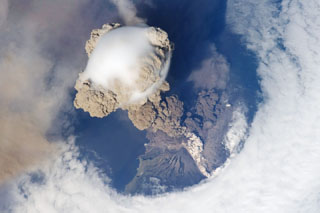Report on Sarychev Peak (Russia) — 17 June-23 June 2009
Smithsonian Institution / US Geological Survey
Weekly Volcanic Activity Report, 17 June-23 June 2009
Managing Editor: Sally Sennert.
Please cite this report as:
Global Volcanism Program, 2009. Report on Sarychev Peak (Russia) (Sennert, S, ed.). Weekly Volcanic Activity Report, 17 June-23 June 2009. Smithsonian Institution and US Geological Survey.
Sarychev Peak
Russia
48.092°N, 153.2°E; summit elev. 1496 m
All times are local (unless otherwise noted)
The eruption from Sarychev Peak that began on 11 June continued through the 19th. SVERT reported another explosive eruption at 1730 UTC on 15 June, followed by the satellite observation of a plume early on 16 June that extended 360 km NW. The Tokyo VAAC estimated that the 16 June plume rose to an altitude of 9.7 km (32,000 feet) a.s.l., while higher ash clouds from earlier explosions reached 13.7 km (45,000 feet) altitude. Ash emissions continued during 17-18 June, causing ashfall in Yuzhno-Sakhalinsk, and gas-and-steam plumes spread NE and SW. Thermal anomalies were detected in satellite data on 18 and 19 June, but cloudy conditions prevented clear observations. One MODIS image on 18 June showed an ash plume spreading SW above the weather clouds. Although the Aviation Color Code was lowered from Red to Orange on 19 June, satellite observations showed that a diffuse ash cloud had spread approximately 20 km S and 40 km W of the volcano.
Geological Summary. Sarychev Peak, one of the most active volcanoes of the Kuril Islands, occupies the NW end of Matua Island in the central Kuriles. The andesitic central cone was constructed within a 3-3.5-km-wide caldera, whose rim is exposed only on the SW side. A dramatic 250-m-wide, very steep-walled crater with a jagged rim caps the volcano. The substantially higher SE rim forms the 1496 m high point of the island. Fresh-looking lava flows, prior to activity in 2009, had descended in all directions, often forming capes along the coast. Much of the lower-angle outer flanks of the volcano are overlain by pyroclastic-flow deposits. Eruptions have been recorded since the 1760s and include both quiet lava effusion and violent explosions. Large eruptions in 1946 and 2009 produced pyroclastic flows that reached the sea.

